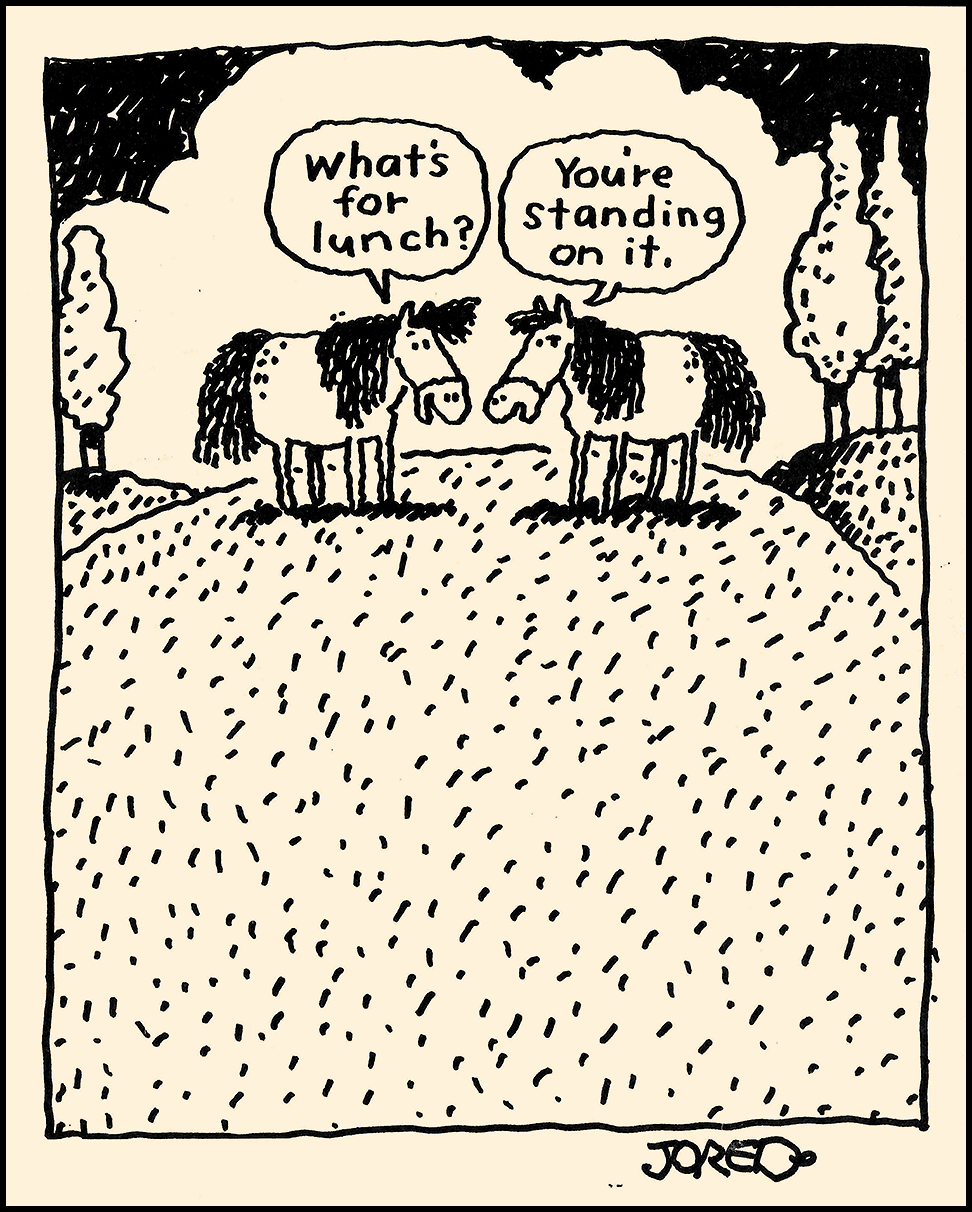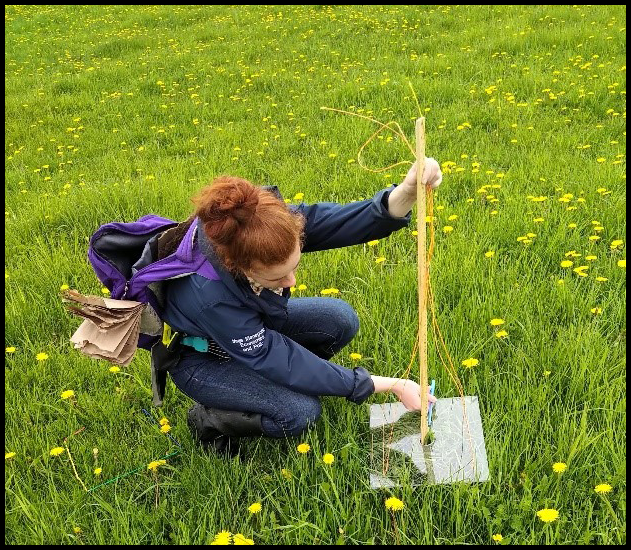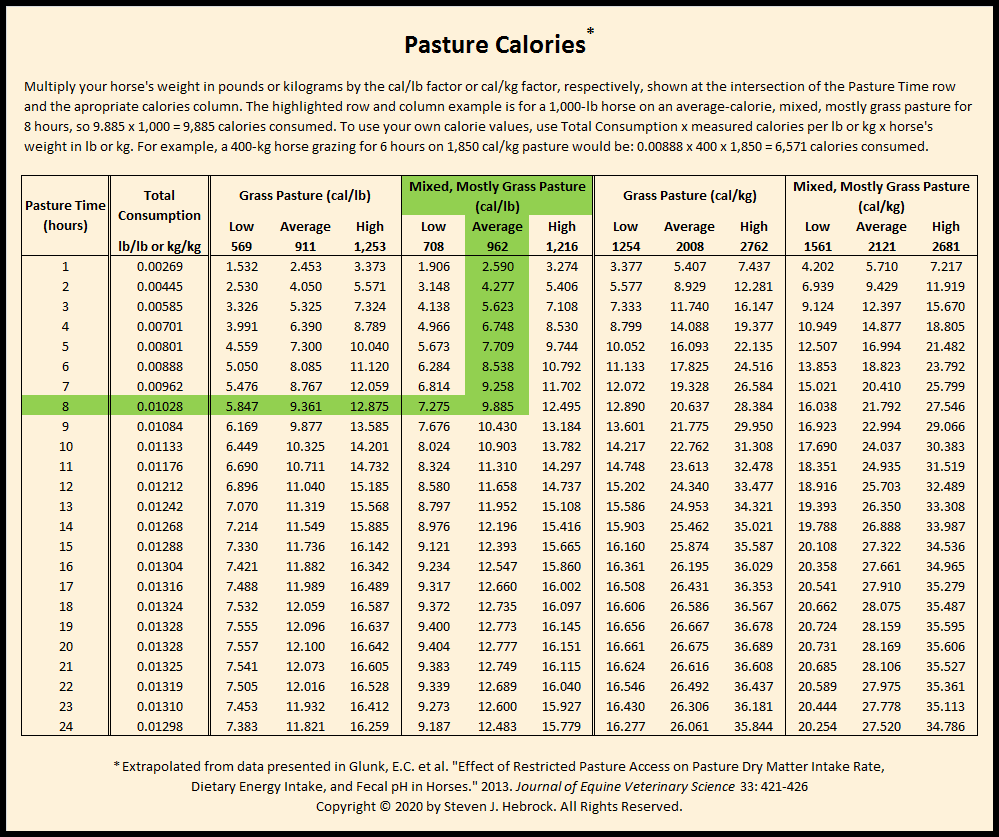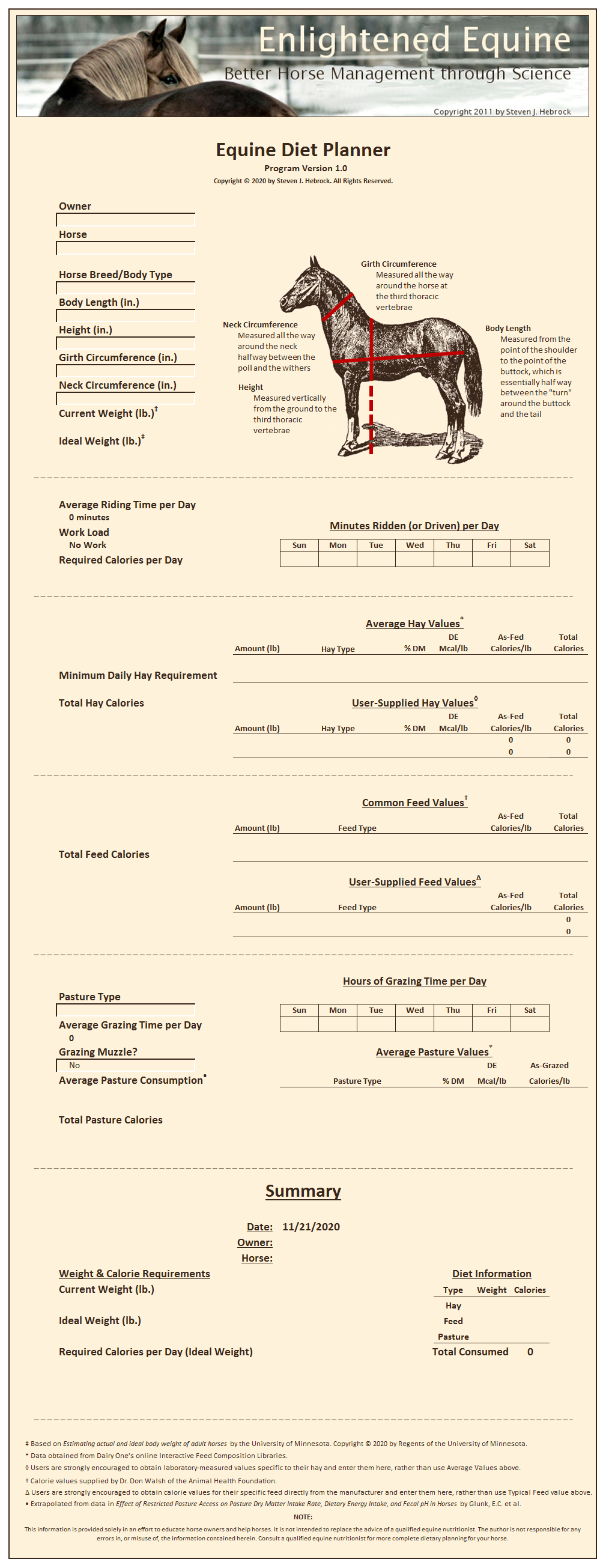Now that we’ve examined the caloric impacts of forage and processed feeds on the horse’s diet in Part 1 and Part 2, respectively, let’s take a look at what happens when grass pasture is added to the mix.
According to Dairy One‘s data, “pure” grass pasture has a Digestible Energy of 911 calories per pound with a Standard Deviation of 171 calories, based on 8,436 samples, while mixed, mostly grass pasture (MMG) has a DE of 962 calories with a S.D. of 127 calories, based on 18,544 samples. That translates to 95% of grass pasture having a DE value between 569 and 1,253 calories, while 95% of mixed grass pasture has a DE content between 708 and 1,216 calories. Why so much variation? Because so many factors affect the amount of sugar in, and therefore the calorie content of, grass. Time of day, time of year, amount of moisture, amount of sunlight, temperature – all these and more influence sugar content.
Attempts to actually measure pasture calories are far more common in the cattle industry than in the horse world, but the process is the same regardless of what species is grazing on it. Most often, a device called a plate meter – either the rising or falling type – is used to collect a series of measurements in a random manner throughout the pasture. These devices work by using a (usually) round, weighted plate of a known size to rest on top of the forage, and the distance from the plate to the ground is then recorded. The plate meter must first be calibrated, however, by taking a distance measurement on forage of the same type, clipping the forage under the plate to post-grazing level (with horses, generally 2.5 cm), and then drying and analyzing the forage sample for calorie content. Although simple in concept, many such samples are required for the calibration process to ensure reasonably-accurate meter measurements – a time-consuming endeavor. But by first collecting and analyzing these samples, a correlation between forage height (the distance measurement) and calories per square unit can be derived. After calibration, the amount of calories in a pasture can be fairly quickly and easily estimated by collecting and averaging a set of measurements. Plate meters are available with a wide range of features from several companies, but you can also construct your own for very little cost.
But…before you spend either a fair amount of money on a manufactured plate meter, or a fair amount of time constructing and calibrating your own plate meter, you may want to consider the following: Research has shown that horses’ rate of consumption of grass pasture varies greatly – and not in an entirely predictable way – depending not only on how much time per day they spend on grass pasture, but also on type of horse, temperature, time of day, season, grass height, grass composition, grass density and other factors, making any attempt at calorie calculations for grazing extremely difficult. For example, grazing researchers at North Carolina State University (Dowler, L.E. et al. 2012. “Determination of Pasture Dry Matter Intake Rates in Different Seasons and Their Application in Grazing Management.” Journal of Equine Veterinary Science 32: 85 – 92) note the following –
…this finding still suggests that horses have the potential to consume relatively large amounts of forage even when grazing for a relatively small portion of the day. These results suggest that DMI [dry matter intake] rate decreases with increased grazing duration and that the extrapolation of 24-hour DMI rates (eg, 2.5% of BW [body weight] in DM/d [dry matter per day]) to grazing periods of <4 hours may result in the underestimation of actual DMI. This may have implications for horse owners trying to manage BW/caloric intake of horses by reducing grazing time, in an effort to manage or prevent various diseases (e.g. laminitis, equine Cushing disease, metabolic disease, insulin resistance).
In other words, the relationship between pasture time and the amount of grass consumed is definitely not a linear one; rather, horses with limited pasture time tend to up their rates of pasture consumption, particularly in the first 4 hours. Simply put, this means: 1) even if the calorie content of a pasture is known, you cannot predict how many calories a horse will consume in a given amount of time with any reasonable degree of accuracy, and 2) you cannot use limited pasture time as a means of reducing calories without almost certainly limiting feed and/or hay availability as well. Interestingly, horses on continuous 24-hour grazing were found to voluntarily consume very close to their total calculated daily energy requirement, with no additional feed and/or hay required.
To further complicate this already-complex situation, some horses simply cannot eat green grass without developing metabolic problems, while others can happily eat green grass all day long and never have an immediate issue. Usually, the older the horse, the more often grass consumption becomes a complication. Because the reasons for these differences in tolerance are not well understood, it falls to the owner to determine whether or not grass causes difficulties for their particular horse. In keeping with my sentiments about mimicking nature in feeding, my personal preference is to allow horses only a very limited amount of green grass, based on the idea that the feral horse in his aboriginal environment is never in a position to eat mouthful after mouthful of green grass. Feral horses have evolved to eat sparsely-spaced dry, bunch grasses, and have to travel up to 12 miles every day to find sufficient calories; contrary to the increasingly common notion that domestic horses should have as much hay as they’ll eat, feral horses do not have unlimited access to forage, and certainly not to green grass. Expecting a horse to not overeat when plopped in the middle of the horse equivalent of a candy store all day strikes me as completely unreasonable.
Furthermore, I am becoming increasingly convinced that, like Type 2 diabetes in humans, we can help prevent the development of metabolic problems by feeding our horses as if they already had metabolic problems i.e. severely limiting the amount of green grass they eat. So, some sort of properly-designed (which, by the way, most of them are not) so-called “track system,” in which whatever forage present (mostly grass hay, perhaps with very small and widely-spaced-apart patches of green grass) is spread out over as large an area as possible to force the horse to move to be able to eat, seems to be the best situation for our domestic horses at present.
So there you have it: Although we can use average values to give us a rough idea of the calorie impact of grazing, just as we did with hay and with feed, the (even greater) number of variables affecting not only the forage itself, but also the horse’s rate of consumption, mean that such “guesstimates” should be used only as a very rough starting point for diet planning.
Based on what little published research has been done on the pasture dry matter consumption rates of horses, the average of the rates of consumption reported in these studies is 0.127 pounds of dry matter per 100 pounds of body weight per hour, plus or minus 0.032 pounds per 100 pounds body weight per hour. But keep in mind that that value is only reasonably accurate for longer grazing times – say, those over 3 or 4 hours. So instead of using that value, I’ve taken the 3-, 6-, 9-, and 24-hour measured grazing rate values from some North Carolina State University research, and extrapolated the intermediate values to create the following chart –
Make no mistake: This is a very rough estimate of calories consumed through grazing, as you’ll note by the wide range of values between the Low and High numbers. The next step towards improving the accuracy would be to use actual measured calorie values from your pasture, but, again, it’s still going to be an approximation.
In an attempt to make things a bit simpler, I’ve created an Equine Diet Planner in MS Excel, which you can either download for use on your own computer or use online within your browser.
As you can see in the screenshot of the Planner below, it incorporates the University of Minnesota weight calculator, which calculates Current and Ideal Weights, and then continues in the following section to calculate Required Calories by entering daily riding times.
The next section allows you to choose the amount and type of hay you’re feeding, or enter your own hay sample results, to calculate Total Hay Calories. Similarly, the feed section computes Total Feed Calories from the amount and type of feed, including allowing you to use values for a brand not on the drop-down list, which you can either obtain directly from the manufacturer or have tested by an independent testing laboratory.
The pasture grazing section has several choices for types of pasture, and then estimates Total Pasture Calories based on grazing time and whether or not your horse is muzzled. As I’ve noted above, pasture consumption is undoubtedly the most difficult to predict, but this will help give you at least a point of departure for diet planning.
Finally, the Summary section at the end adds together the previously-calculated calorie values to give an overall picture of your horse’s diet. It also cautions you when the calorie intake exceeds or falls short of the calories required to maintain proper (ideal) body weight by more than 5%.
I would strongly encourage you to use this Planner to develop a better understanding of what and how much your horse is currently eating versus what he actually needs to maintain a healthy body weight, and I would encourage you to share it – and the information/videos from the first two parts of this series – with your friends and your barn owner as well. Because of the very large number of variables involved, though, please remember that ultimately the only certain guide to whether or not you’re under- or over-feeding your horse is an honest eye!
To wrap up both this Post and this series, here are a few things to keep in mind:
- Be honest about your horse’s weight. If you can’t be objective, ask someone else to take a look. Better still, use accurate measurements in the weight calculator and trust the results.
- Be honest about how much you actually work your horse. Time spent tacking up, walking to and from the arena, etc. doesn’t count as work time, nor does simply sitting on your horse while he walks around. Think of it this way: If you wouldn’t be sweating and/or breathing hard doing what he’s doing, it’s not work and shouldn’t be counted as such.
- Be honest about what and how much your horse is eating. Weigh everything. Do the math, and figure out the best way to feed only what he requires to attain/maintain a healthy weight, spread over a 24-hour period.
- Have your hay tested. It’s relatively easy and inexpensive, and since hay should far and away constitute the bulk of every horse’s diet, knowing how many calories are in it is important.
- Remember that you can’t feed muscle onto a horse. If your horse has a bad top line or otherwise lacks muscle mass, increase his work load and feed the consequent higher calorie demand; don’t expect to put healthy weight on a horse with just food. And don’t try to rush either the weight loss or the weight gain process; feed for his calorie requirements, and things will take care of themselves.
- Consider your particular situation when planning your horse’s diet. If you board, you may have very little to no control over certain aspects of your horse’s diet, such as pasture time or brand of feed, so control what you can: Use a grazing muzzle, reduce the amount of feed, increase the amount of hay, etc.
- Remember that things can, and do, change. Your horse’s current dietary requirements may be very different from his requirements several years ago. Be aware of the impact of pasture time on his diet, and adjust his diet accordingly.
- Finally, be logical in your approach to feeding. Consider how nature feeds the feral horse, and remember that mimicking nature will generally yield good results. Keep in mind there is plenty of bad advice out there, including from those with PhD and DVM after their names. If what is offered is inconsistent with what I’ve presented in this series of articles, be suspicious!
Much more to come…



